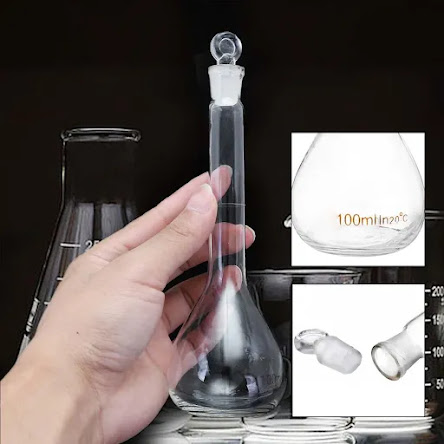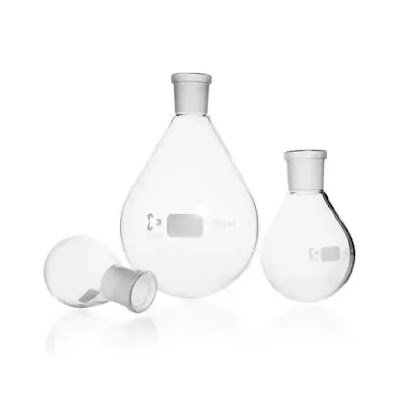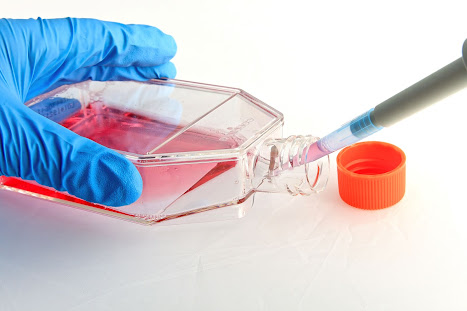Laboratory Flask – Materials, Types, Use
Laboratory flasks are lab vessels with wide bodies and narrow, tubular necks. They can be used for mixing, measuring, and heating chemicals, samples, and solutions. A type of labware, laboratory flasks are made of glass or plastic and specified by volume. Often, a stopper or cap is used to seal the opening at the neck.
What is Laboratory flask?
- Glassware is the category of laboratory equipment that includes laboratory flasks. In the laboratory and other scientific contexts, flasks are typically referred to as flasks.
- There are a variety of flask forms and sizes, but one defining feature is a broader vessel “body” and one (or sometimes more) narrower tubular pieces at the top called necks that have an opening at the top.
- The capacity of laboratory flasks is normally given in metric units such as millilitres (mL or ml) or litres (L or l).
- Traditionally, laboratory flasks were constructed of glass, however plastic can also be used.
- Some glass flasks, such as round-bottom flasks, retorts, and occasionally volumetric flasks, have outer (or female) tapering (conical) ground glass joints at the opening(s) at the top of the neck.
- Some flasks, particularly volumetric flasks, include a rubber stopper, bung, or cap for capping the opening at the top of the neck. These stoppers may be made of plastic or glass.
- Typically, glass stoppers feature a matching tapering inner (or male) ground glass joint surface, but typically only stopper-grade glass.
- Flasks that do not feature such stoppers or caps may be capped using a cork stopper or rubber bung.
- Flasks can be used for holding, containing, collecting, or occasionally volumetrically measuring chemicals, samples, solutions, etc. for chemical reactions or other operations like mixing, heating, chilling, dissolving, precipitating, boiling (as in distillation), or analysis.
Lab Flask Materials
Additionally, laboratory flasks can be classified by their
construction material. There are two fundamental varieties: glass and plastic.
There are numerous subtypes as well.
Glass Flasks
- Glass flasks are typically fabricated from fused silica, borosilicate, or quartz glass, as well as proprietary commercial glasses such as KIMAX® (Kimble Chase) or Pyrex® (Corning).
- When selecting products, purchasers must take their application requirements into account. borosilicate glass flasks, for instance, can survive thermal stress and chemical attack. Fused silica is suited for applications requiring excellent thermal stability over the long term.
Plastic Flasks
- Plastic flasks are constructed from fluoropolymer resins and elastomers, rubber, polyamides, common polymers, and custom plastics.
- As with glass flasks, laboratory glassware purchasers must evaluate their application needs while buying items. For instance, EPDM flasks have a high resistance to ultraviolet (UV) light, but their weak resistance to fuels renders them unsuitable for petroleum-related applications.
Types of flasks
There are various varieties of laboratory flasks, each of
which serves a unique purpose in the laboratory. Because of their function,
flasks can be classified as:
Reaction flasks: Reaction flasks are typically
spherical (i.e., round-bottom flasks) and are accompanied by their necks, at
the ends of which are ground glass joints to connect rapidly and securely to
the rest of the apparatus (such as a reflux condenser or dropping funnel). The
reaction flask is often composed of thick glass and can withstand substantial
pressure variations; as a result, it is sometimes possible to maintain a
reaction both under vacuum and pressure. Some variants are: Multiple neck
flasks: Numerous neck flasks can have two to five, and less frequently, six
necks, each topped by a ground glass connection. These flasks are utilised in
processes that need the controlled mixing of multiple chemicals and are used
with multiple necks. Schlenk flask: Schlenk flasks are spherical flasks
with ground glass openings, hose outlets, and vacuum stopcocks. The tap
facilitates the connection of the flask to a vacuum-nitrogen line via the hose
and the performance of a reaction in either a vacuum or a nitrogen environment.
Distillation flasks: The purpose of distillation
flasks is to hold mixtures subject to distillation and to collect the results
of distillation. There are numerous shapes available for distillation flasks.
Similar to reaction flasks, distillation flasks typically feature a single
narrow neck and a ground glass joint. However, they are composed of thinner
glass than reaction flasks, making them easier to heat. Due to their employment
with Kjeldahl bulbs, they are sometimes spherical, test tube-shaped, or
pear-shaped and are sometimes known as Kjeldahl Flasks.
Reagent flasks: Typically, flasks for reagents have
flat bottoms, allowing them to be placed on a table or in a cabinet. Due to the
strains caused by a flat bottom, these flasks cannot sustain excessive pressure
or temperature changes; they are typically manufactured of weaker glass than
reaction flasks. Certain types of flasks are provided with a ground glass
stopper, while those with threaded necks are supplied with an appropriate nut
or an automatic dispenser. Two typical shapes are available for these flasks: Round-bottom
flasks: Flasks with a round bottom resemble a tube rising from the top of a
spherical. Typically, flasks have a lengthy neck; occasionally, they have an
incision on the neck that exactly determines the flask’s volume. They can be
utilised in distillations and heating processes. These flasks are also referred
to as Florence flasks. Flasks with flat bottom.
Cassia flasks: Cassia flasks for essential oil
analysis and aldehyde testing, about. 100 ml, neck graded 0 – 6: 0,1 ml.
Erlenmeyer flask : Emil Erlenmeyer (1825-1900), a
German scientist, created the Erlenmeyer flask in 1861. Conical flasks are
often used due to their inexpensive cost (they are simple to produce) and
portability.
Boiling or Florence Flask: These big, circular flasks
are utilised for boiling. The flask features a long, thin neck and a rim
aperture that is gently flared. The spherical bottom design makes it simple to
heat the contained solution using a Bunsen burner. While some Florence flasks
are created with round bottoms and require support to stand, we also have
Florence flasks with flat bottoms that can stand on their own.
Volumetric flask: The volumetric flask is used for
precisely measuring liquid quantities. It has a roughly pear-shaped body and a
long neck with a circumferential fill line.
Dewar flask: The Dewar flask is a double-walled flask
with an almost-vacuum between the walls. These are available in a range of
sizes and shapes; some are huge and tube-like, while others resemble standard
flasks.
Evaporating flasks: Evaporating flasks (for rotary
evaporator) that are centred, pear-shaped, and equipped with a socket or a
flange.
Powder flasks: Pear-shaped powder flasks for the
drying of powdered material, with a socket.
Büchner flask or Sidearm flask or Suction flask: They are flasks with a flat bottom, but made
of strong and durable glass. They often have a cone form, similar to that of an
Erlenmeyer flask, with a side neck, which is typically attached 2/3 of the way
up from the bottom. The flasks are used in conjunction with vacuum aspirators
or vacuum pumps during vacuum filtering, or as additional protection during
distillation and other low-pressure procedures.
Culture flasks: The design of culture flasks for
growing cells incorporates baffles that aid in mixing when put on a shaker
table.
Other Types of flasks: Beaker (glassware), Retorts are
simplified distillation device with long, sloping necks and circular bases.
They have been substantially superseded by condensers.
Uses of flasks
- Flasks are utilised for chemical reactions.
- Various neck flasks are utilised in procedures that demand the controlled mixing of multiple chemicals and are therefore more difficult.
- Used to carry out a reaction in either a vacuum or a nitrogen atmosphere.
- Used to hold mixtures submitted to distillation and to collect the distillate.
- They can be utilised in distillations and heating processes.
- Used for essential oil analysis and aldehyde determination.
- utilised for preparing liquids in precise amounts
- Utilized for the drying of powdered goods, fashioned like a pear, with a socket.
- Used in conjunction with vacuum aspirators or vacuum pumps during vacuum filtering, or as an additional safety measure during distillation and other low-pressure operations.
- Used for cell growth.
References
https://www.fishersci.se/se/en/products/I9C8KCQS/flasks.html
https://www.chemeurope.com/en/encyclopedia/Laboratory_flask.html
https://www.homesciencetools.com/chemistry/glassware-plasticware/flasks/
https://www.scienceequip.com.au/blogs/news/types-of-flasks-used-in-laboratory
https://www.thomasnet.com/articles/instruments-controls/types-of-lab-flasks/





















.webp)

No comments